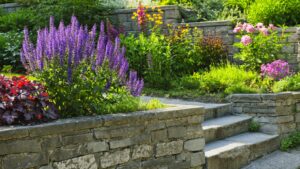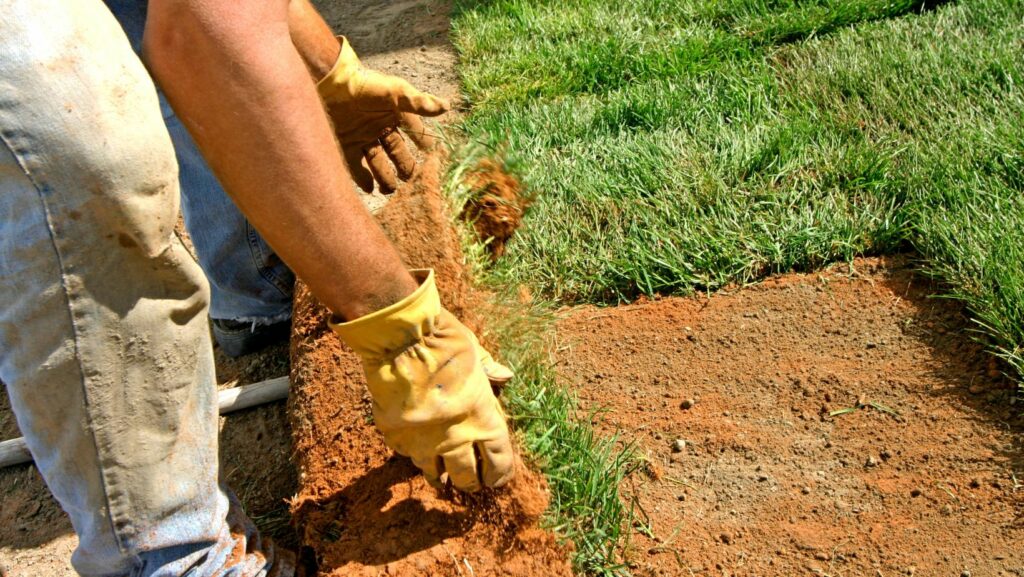Landscaping on a Slope Near House
Sloped landscapes are prone to erosion due to the natural flow of water downhill. To prevent erosion, installing erosion control measures such as retaining walls, ground covers, and mulching is essential. These measures help stabilize the soil and prevent it from washing away during heavy rains or watering.
One of the significant challenges of landscaping on a slope is managing water drainage. Improper drainage can lead to water pooling near the house’s foundation, causing structural damage over time. To address this issue, homeowners can consider installing French drains, dry creek beds, or creating swales to direct water away from the house effectively.
Choosing the right plants for a sloped landscape is crucial for ensuring their health and survival. Plants with deep roots, such as groundcovers, ornamental grasses, and native shrubs, are ideal for slopes as they help prevent soil erosion and stabilize the ground. Additionally, selecting drought-tolerant plants can reduce the need for frequent watering and maintenance in a sloped garden.
Soil Preparation and Terracing
Building Retaining Walls

In landscaping on a slope near a house, constructing retaining walls is crucial. Retaining walls help prevent soil erosion, create distinct levels for planting, and enhance the overall aesthetics of the landscape. They provide structural support to keep soil in place, especially on steep slopes. It’s essential to choose durable materials such as concrete blocks, natural stone, or timber for building retaining walls that can withstand the pressure of the soil behind them.
Retaining walls can be built in various styles, including stacked stone walls for a natural look or concrete walls for a more modern feel. Proper drainage behind the retaining wall is essential to prevent water buildup and ensure the stability of the structure. Hiring professionals for the design and installation of retaining walls is recommended to ensure proper construction and long-term effectiveness.
Creating Level Terraces for Planting
When landscaping on a sloped area near a house, creating level terraces is an effective way to maximize usable space for planting and outdoor activities. Terracing involves building a series of flat areas on the slope, providing stable ground for gardens, patios, or seating areas. By creating terraces, you can control water runoff, improve soil retention, and enhance the visual appeal of the landscape.
To create level terraces, one can use various materials such as timber, stone bricks, or concrete blocks to build retaining walls that define each terrace’s boundary. Proper planning is essential to ensure that each terrace is level, adequately drained, and suitable for the intended use.
Hardscaping Elements for Slopes
Staircases and Steps

Staircases and steps are essential hardscaping features when dealing with sloped landscapes. Installing these elements not only provides safe access to different levels of the terrain but also adds an architectural touch to the outdoor space. By carefully integrating staircases into the design, one can effectively navigate the slope while enhancing the overall aesthetic of the area.
Pathways and Walkways
Creating pathways and walkways on sloped terrains not only improves accessibility but also contributes to the overall design cohesion of the landscape. Well-designed pathways help define the flow of the outdoor space, guiding individuals through the garden while preventing erosion on the slope. Utilizing materials that offer both durability and slip resistance is crucial when constructing pathways on inclines to ensure both safety and longevity.
Managing Water on a Sloped Landscape
Optimizing water drainage is crucial in landscaping on slopes near houses to prevent erosion and water accumulation. Utilizing French drains, dry wells, or swales helps redirect water away from the house’s foundation, preventing structural damage. Installing a series of strategically placed pipes or channels can effectively manage water flow, protecting the landscape and the house itself.
When incorporating water features into a sloped landscape near a house, it’s essential to do so mindfully. Water features like cascading waterfalls or small ponds can add beauty and tranquility to the environment. However, ensure proper planning to prevent water from pooling near the house and causing drainage issues. Integrating water features with the overall landscape design can create a harmonious and aesthetically pleasing outdoor space.
Landscaping on slopes near houses presents unique challenges and opportunities. Implementing techniques like terraced gardens and retaining walls not only enhances aesthetics but also prevents erosion. Proper drainage systems are essential for maintaining the integrity of sloped landscapes. Incorporating hardscaping elements like staircases and pathways adds functionality and visual interest. Regular maintenance, including inspecting for erosion and monitoring plant health, is crucial for a vibrant landscape.
